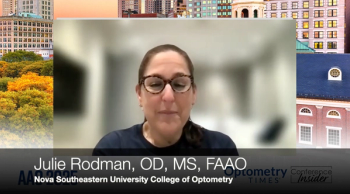
Bariatric surgery may be linked to changes on corneal sensitivity
In a presentation at the American Academy of Optometry 2021 annual meeting in Boston, Stuti Misra, BOptom, PhD, offered insight into her research, which found that bariatric surgery may result in more benefits than just weight loss for patients.
Reviewed by Stuti Misra, PhD
Bariatric surgery may result in more than just weight loss. Investigators in New Zealand also observed a reduction in the corneal sensitivity threshold, suggesting a marked improvement in corneal sensitivity, according to Stuti Misra, BOptom, PhD, with the Department of Ophthalmology at the University of Auckland in Auckland, New Zealand.
“Bariatric surgery, also called weight-loss surgery, reportedly reverses type 2 diabetes in most patients, however, the status of diabetes-related complications post-surgery is not well reported,” Misra said. “As the number of these procedures is expected to increase within the next decade, there is a need to investigate whether any diabetes associated comorbidities, for example, diabetic peripheral neuropathy and diabetes-related ocular surface changes, reverse along with improved HbA1c and BMI.”
Misra presented her findings in a presentation at the American Academy of Optometry 2021 annual meeting in Boston. With her colleagues, she conducted a study to investigate the relationships between the neuropeptides substance P and calcitonin gene related peptide (CGRP) and corneal sensitivity, the glycated state of hemoglobin A1c (HbA1c), peripheral neuropathy, and body mass index (BMI) before and after bariatric surgery was performed.
“Those findings indicated that some neuropeptides may act as biomarkers for ocular surface health in diabetes,” Misra explained.
Parameters evaluated
Investigators assessed patients before they underwent bariatric surgery and at 12, 26, and 52 after the surgery. Those who had undergone a previous bilateral surgery or had a systemic disease associated with peripheral neuropathy were not included in the study.
The investigators performed non-contact aesthesiometry to measure the corneal sensitivity, and they collected tears using the flush technique. The modified total neuropathy score was used to determine the status of the peripheral neuropathy. Enzyme-linked immunosorbent assays of the tear film determined the concentration of the total protein content, substance P, and CGRP.
The results
A total of 29 patients (18 women) were included in the study. The mean BMI was 44.7 ± 6.4 kg/m2. The patients had had diabetes for a mean of 11±7.6 years. The BMI and HbA1c both decreased significantly after the surgery (p < 0.001,for both comparisons). The baseline non-contact aesthesiometry measurement was 1.109 σ 0.795 mBAR and decreased significantly at 52 weeks to 0.6218 σ 0.5370 mBAR (p=0.0295).
The baseline CGRP concentration increased significantly at 26 weeks (p<0.001) and between 12 weeks and 26 weeks (p=0.021), but the increase was not maintained by the end of the study at 52 weeks, suggesting a return of the CGRP concentration to the baseline level the investigators reported.
The concentrations of total protein concentration and substance SP did not change significantly during the study.
Significant correlations were found among the neuropeptides themselves, but none was correlated significantly with any measured non-contact aesthesiometry value, the modified total neuropathy score, or the HbA1c. The CGRP concentration showed a significant (p = 0.014) inverse relationship with the BMI.
According to investigators, an improvement in glycemic control and BMI was noted after the bariatric surgery.
“A reduction in the corneal sensitivity threshold also suggested marked improvement in corneal sensitivity,’ they concluded. “Interestingly, we observed a mechanism in the ocular surface by which neuropeptide CGRP increased in the tear film after bariatric surgery; however, it stabilized within a year. This could indicate a repair process during the initial months of recovery.”
Stuti Misra, BOptom, PhD
This article is adapted from Misha’s poster presentation at the American Academy of Optometry 2021 annual meeting in Boston. The investigators have no financial interest in this subject matter.
Bariatric surgery may result in more than just weight loss. Investigators in New Zealand also observed a reduction in the corneal sensitivity threshold, suggesting a marked improvement in corneal sensitivity, according to Stuti Misra, BOptom, PhD, with the Department of Ophthalmology at the University of Auckland in Auckland, New Zealand.
“Bariatric surgery, also called weight-loss surgery, reportedly reverses type 2 diabetes in most patients, however, the status of diabetes-related complications post-surgery is not well reported,” Misra said. “As the number of these procedures is expected to increase within the next decade, there is a need to investigate whether any diabetes associated comorbidities, for example, diabetic peripheral neuropathy and diabetes-related ocular surface changes, reverse along with improved HbA1c and BMI.”
Misra presented her findings in a presentation at the American Academy of Optometry 2021 annual meeting in Boston. With her colleagues, she conducted a study to investigate the relationships between the neuropeptides substance P and calcitonin gene related peptide (CGRP) and corneal sensitivity, the glycated state of hemoglobin A1c (HbA1c), peripheral neuropathy, and body mass index (BMI) before and after bariatric surgery was performed.
She explained that performing this study was based on the knowledge that significant alterations in tear film neuropeptides, including reductions in the levels of substance P in patients with diabetes.
“Those findings indicated that some neuropeptides may act as biomarkers for ocular surface health in diabetes,” Misra explained.
Parameters evaluated
Investigators assessed patients before they underwent bariatric surgery and at 12, 26, and 52 after the surgery. Those who had undergone a previous bilateral surgery or had a systemic disease associated with peripheral neuropathy were not included in the study.
The investigators performed non-contact aesthesiometry to measure the corneal sensitivity, and they collected tears using the flush technique. The modified total neuropathy score was used to determine the status of the peripheral neuropathy. Enzyme-linked immunosorbent assays of the tear film determined the concentration of the total protein content, substance P, and CGRP.
The results
A total of 29 patients (18 women) were included in the study. The mean BMI was 44.7 ± 6.4 kg/m2. The patients had had diabetes for a mean of 11±7.6 years. The BMI and HbA1c both decreased significantly after the surgery (p < 0.001,for both comparisons). The baseline non-contact aesthesiometry measurement was 1.109 σ 0.795 mBAR and decreased significantly at 52 weeks to 0.6218 σ 0.5370 mBAR (p=0.0295).
The baseline CGRP concentration increased significantly at 26 weeks (p<0.001) and between 12 weeks and 26 weeks (p=0.021), but the increase was not maintained by the end of the study at 52 weeks, suggesting a return of the CGRP concentration to the baseline level the investigators reported.
The concentrations of total protein concentration and substance SP did not change significantly during the study.
Significant correlations were found among the neuropeptides themselves, but none was correlated significantly with any measured non-contact aesthesiometry value, the modified total neuropathy score, or the HbA1c. The CGRP concentration showed a significant (p = 0.014) inverse relationship with the BMI.
According to investigators, an improvement in glycemic control and BMI was noted after the bariatric surgery.
“A reduction in the corneal sensitivity threshold also suggested marked improvement in corneal sensitivity,’ they concluded. “Interestingly, we observed a mechanism in the ocular surface by which neuropeptide CGRP increased in the tear film after bariatric surgery; however, it stabilized within a year. This could indicate a repair process during the initial months of recovery.”
Stuti Misra, BOptom, PhD
This article is adapted from Misha’s poster presentation at the American Academy of Optometry 2021 annual meeting in Boston. The investigators have no financial interest in this subject matter.
Newsletter
Want more insights like this? Subscribe to Optometry Times and get clinical pearls and practice tips delivered straight to your inbox.













































